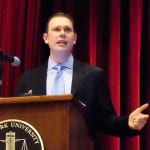Day 2 of Energy Finance 2015 kicked off this morning with a headline quote from Paul Coster of JPMorgan Chase: “2014 was a historic year for investments for renewables.”
Coster knows whereof he speaks as the lead alternative-energy analyst for JPMorgan Chase and a seasoned Wall Street figure who has a deep understanding of these markets.
Highlights from his talk:
- New investment in renewable generating capacity exceeded fossil fuel-based capacity investment for the first time last year.
- Investment in renewables reached $310 billion, up by approximately 16 percent year over year, led by the Asia Pacific region, by solar and by asset finance, even though renewables still make up a very small portion of global energy generation (lots of upside there).
- By the end of 2015, more than 700 gigawatts of wind and solar capacity will be installed globally, and this number will double by 2020.
- Cash available for distribution to investors is likely to also double, resulting in an industry-wide dividend of about $145 billion. A growing portion of this will flow into publicly traded Yieldcos, which are structured around renewable-energy investments so that they generate predictable cash flows.
CARBON-REGULATION COMPLIANCE IS ‘FRONT AND CENTER,’ AND RENEWABLES ARE NOW MAINSTREAM

Another Wall Street presence of note: Julien Dumoulin-Smith, a utility-industry savant from UBS Investment Research who noted that carbon-regulation compliance is “front and center” today for energy companies.
Dumoulin-Smith said in a Monday afternoon presentation that a cap-and-trade exchange for carbon is inevitable and that it may first emerge regionally, and could do so without a government mandate.
Renewables are now mainstream, he said, as the economics of wind and solar continue to improve and as energy companies engage en masse in “de-risking” by becoming increasingly diversified through investments in wind and solar. Much of those investment, he added, will be driven by persistently low interests rates, and he added this caveat: low rates may not last forever.
Enforcement of EPA air-quality standards around “criteria pollutants” — Dumoulin-Smith pointed to these EPA standards—will drive the trend toward more and more retirements of coal-fired plants.
WHY THE U.S. COAL-FIRED BUILDOUT FAILED
During a Monday afternoon panel that exploring the risks that rose to keep an ambitious national coal-plant agenda 10 years ago from coming to pass, IEEFA’s David Schlissel said the coal-industry push would have succeeded if not for citizen opposition.
“If there had been no environmental movement between 2005 and 2015, a lot more plants would have been built because no one would have been speaking truth to power,” Schlissel said. “You can’t quantify it, but certainly it’s essential for people to be there doing what all of us in this room do.”
Schlissel noted that out of 249 proposed coal in 2007, 183 have been canceled, 22 were completed and 44 are in limbo. The scheme faltered, he said, because the plants became economically untenable due to skyrocketing construction costs, the rise of cheap natural gas, widespread citizen opposition and increasing skepticism on the part of investors.
Additional perspective from Tom Sanzillo, IEEFA’s director of finance: “Anything we could use to disrupt the ability of the industry to get these coal plants built, we used,” including litigation, talking directly to state governors, and meeting with bank officials to discuss the financial risks of investing in coal-reliant assets.
A REPORT FROM GRASSROOTS CENTRAL: BATAVIA, ILLINOIS

Also in the spotlight: Betsy Zinser, a resident of Batavia, Ill., who has been prominent in raising some of the many ongoing questions about the Prairie State Energy Campus, a construct of Peabody Coal that supplies overpriced electricity to dozens of communities around the Midwest.
Zinser noted that Peabody built and sold the plant at a time in which most cities and towns in the region were moving away from coal-fired electricity and that Peabody marketed it anyway as a low-cost, stable source of energy. Quite the opposite has happened.
While the original estimate for the constructions costs was $2.5 billion, Zinser noted, the final cost was $5 billion, the debt incurred was double the original estimate, and 50 percent of the cost of electricity from Prairie State now goes toward debt service.
Zinser said community activists in Batavia have helped initiate the following:
- A Securities Exchange Commission investigation into how the Prairie State deal went down;
- A formal request by the city of Batavia to the attorney general of Illinois to open an investigation;
- A ratepayer class action lawsuit;
- Support from Illinois state legislators.
IEEFA’s Board President Larry Shapiro, in response to a question from an audience member about the most effective community organizing tactics, said this: “Find the people in the relevant community who are as different from you as you can possibly imagine. If you want to win, you better make alliances with all kinds of different people, most of whom are going to be a lot different from who we are.”
Source: IEEFA. Reproduced with permission.







